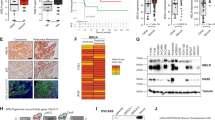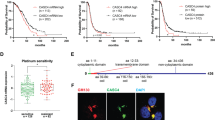Abstract
Epithelial ovarian carcinoma is the most common cause of death from gynecologic cancers largely due to advanced, relapsed and chemotherapy-resistant peritoneal metastasis, which is refractory to the currently used treatment approaches. Mechanisms supporting advanced and relapsed peritoneal metastasis are largely unknown, precluding development of more effective targeted therapies. In this study, we investigated the function of a potentially targetable fractalkine axis in the formation and the development of advanced and relapsed peritoneal metastasis and its impact on patients’ outcomes. Our mouse model studies support a role for the fractalkine receptor (CX3CR1) in the initiation of peritoneal adhesion important for recolonization of relapsed peritoneal metastasis. We show that downregulation of CX3CR1 results in reduction of metastatic burden at several peritoneal sites commonly colonized by advanced and relapsed metastatic ovarian carcinoma. We show that the chemokine fractalkine (CX3CL1), an activating ligand of CX3CR1, regulates organ-specific peritoneal colonization. High expression of CX3CR1 correlates with significantly shorter survival, specifically in post-menopausal patients with advanced and terminal stages of the disease. Taken together, our studies support a key regulatory role for the fractalkine axis in advanced and relapsed peritoneal metastasis in epithelial ovarian carcinoma.
This is a preview of subscription content, access via your institution
Access options
Subscribe to this journal
Receive 50 print issues and online access
$259.00 per year
only $5.18 per issue
Buy this article
- Purchase on Springer Link
- Instant access to full article PDF
Prices may be subject to local taxes which are calculated during checkout







Similar content being viewed by others
References
Auersperg N . The origin of ovarian carcinomas: a unifying hypothesis. Int J Gynecol Pathol 2011; 30: 12–21.
Crum CP, Herfs M, Ning G, Bijron JG, Howitt BE, Jimenez CA et al. Through the glass darkly: intraepithelial neoplasia, top-down differentiation, and the road to ovarian cancer. J Pathol 2013; 231: 402–412.
Dubeau L . The cell of origin of ovarian epithelial tumours. Lancet Oncol 2008; 9: 1191–1197.
Dubeau L, Drapkin R . Coming into focus: the nonovarian origins of ovarian cancer. Ann Oncol 2013; 24 (Suppl 8): viii28–viii35.
Kurman RJ . Origin and molecular pathogenesis of ovarian high-grade serous carcinoma. Ann Oncol 2013; 24 (Suppl 10): x16–x21.
Siegel RL, Miller KD, Jemal A . Cancer statistics, 2016. CA Cancer J Clin 2016; 66: 7–30.
Vaughan S, Coward JI, Bast RC Jr., Berchuck A, Berek JS, Brenton JD et al. Rethinking ovarian cancer: recommendations for improving outcomes. Nat Rev Cancer 2011; 11: 719–725.
Bowtell DD, Bohm S, Ahmed AA, Aspuria PJ, Bast RC Jr., Beral V et al. Rethinking ovarian cancer II: reducing mortality from high-grade serous ovarian cancer. Nat Rev Cancer 2015; 15: 668–679.
Lengyel E . Ovarian cancer development and metastasis. Am J Pathol 2010; 177: 1053–1064.
Chang SJ, Bristow RE, Chi DS, Cliby WA . Role of aggressive surgical cytoreduction in advanced ovarian cancer. J Gynecol Oncol 2015; 26: 336–342.
Pomel C, Jeyarajah A, Oram D, Shepherd J, Milliken D, Dauplat J et al. Cytoreductive surgery in ovarian cancer. Cancer Imaging 2007; 7: 210–215.
Seward SM, Winer I . Primary debulking surgery and neoadjuvant chemotherapy in the treatment of advanced epithelial ovarian carcinoma. Cancer Metastasis Rev 2015; 34: 5–10.
Bookman MA . First-line chemotherapy in epithelial ovarian cancer. Clin Obstet Gynecol 2012; 55: 96–113.
Colombo PE, Fabbro M, Theillet C, Bibeau F, Rouanet P, Ray-Coquard I . Sensitivity and resistance to treatment in the primary management of epithelial ovarian cancer. Crit Rev Oncol Hematol 2014; 89: 207–216.
Davis A, Tinker AV, Friedlander M . "Platinum resistant" ovarian cancer: what is it, who to treat and how to measure benefit? Gynecol Oncol 2014; 133: 624–631.
Wiedemeyer WR, Beach JA, Karlan BY . Reversing platinum resistance in high-grade serous ovarian carcinoma: targeting brca and the homologous recombination system. Front Oncol 2014; 4: 34.
Thibault B, Castells M, Delord JP, Couderc B . Ovarian cancer microenvironment: implications for cancer dissemination and chemoresistance acquisition. Cancer Metastasis Rev 2014; 33: 17–39.
Vanneman M, Dranoff G . Combining immunotherapy and targeted therapies in cancer treatment. Nat Rev Cancer 2012; 12: 237–251.
Kim M, Rooper L, Xie J, Kajdacsy-Balla AA, Barbolina MV . Fractalkine receptor CX(3)CR1 is expressed in epithelial ovarian carcinoma cells and required for motility and adhesion to peritoneal mesothelial cells. Mol Cancer Res 2012; 10: 11–24.
Gaudin F, Nasreddine S, Donnadieu AC, Emilie D, Combadiere C, Prevot S et al. Identification of the chemokine CX3CL1 as a new regulator of malignant cell proliferation in epithelial ovarian cancer. PloS One 2011; 6: e21546.
Gurler H, Macias V, Kajdacsy-Balla AA, Barbolina MV . Examination of the Fractalkine and Fractalkine Receptor Expression in Fallopian Adenocarcinoma Reveals Differences When Compared to Ovarian Carcinoma. Biomolecules 2015; 5: 3438–3447.
Rooper L, Gurler H, Kajdacsy-Balla AA, Barbolina MV . Fractalkine receptor is expressed in mature ovarian teratomas and required for epidermal lineage differentiation. J Ovarian Res 2013; 6: 57.
Balkwill F . Cancer and the chemokine network. Nat Rev Cancer 2004; 4: 540–550.
Mantovani A, Savino B, Locati M, Zammataro L, Allavena P, Bonecchi R . The chemokine system in cancer biology and therapy. Cytokine Growth Factor Rev 2009; 21: 27–39.
Proudfoot AE . Chemokine receptors: multifaceted therapeutic targets. Nat Rev Immunol 2002; 2: 106–115.
Tautermann CS . GPCR structures in drug design, emerging opportunities with new structures. Bioorg Med Chem Lett 2014; 24: 4073–4079.
Combadiere C, Salzwedel K, Smith ED, Tiffany HL, Berger EA, Murphy PM . Identification of CX3CR1. A chemotactic receptor for the human CX3C chemokine fractalkine and a fusion coreceptor for HIV-1. J Biol Chem 1998; 273: 23799–23804.
Imai T, Hieshima K, Haskell C, Baba M, Nagira M, Nishimura M et al. Identification and molecular characterization of fractalkine receptor CX3CR1, which mediates both leukocyte migration and adhesion. Cell 1997; 91: 521–530.
Bazan JF, Bacon KB, Hardiman G, Wang W, Soo K, Rossi D et al. A new class of membrane-bound chemokine with a CX3C motif. Nature 1997; 385: 640–644.
Hundhausen C, Misztela D, Berkhout TA, Broadway N, Saftig P, Reiss K et al. The disintegrin-like metalloproteinase ADAM10 is involved in constitutive cleavage of CX3CL1 (fractalkine) and regulates CX3CL1-mediated cell-cell adhesion. Blood 2003; 102: 1186–1195.
Tsou CL, Haskell CA, Charo IF . Tumor necrosis factor-alpha-converting enzyme mediates the inducible cleavage of fractalkine. J Biol Chem 2001; 276: 44622–44626.
Harrison JK, Jiang Y, Chen S, Xia Y, Maciejewski D, McNamara RK et al. Role for neuronally derived fractalkine in mediating interactions between neurons and CX3CR1-expressing microglia. Proc Natl Acad Sci USA 1998; 95: 10896–10901.
Jamieson WL, Shimizu S, D'Ambrosio JA, Meucci O, Fatatis A . CX3CR1 is expressed by prostate epithelial cells and androgens regulate the levels of CX3CL1/fractalkine in the bone marrow: potential role in prostate cancer bone tropism. Cancer Res 2008; 68: 1715–1722.
Jamieson-Gladney WL, Zhang Y, Fong AM, Meucci O, Fatatis A . The chemokine receptor CX(3)CR1 is directly involved in the arrest of breast cancer cells to the skeleton. Breast Cancer Res 2011; 13: R91.
Marchesi F, Piemonti L, Fedele G, Destro A, Roncalli M, Albarello L et al. The chemokine receptor CX3CR1 is involved in the neural tropism and malignant behavior of pancreatic ductal adenocarcinoma. Cancer Res 2008; 68: 9060–9069.
Shulby SA, Dolloff NG, Stearns ME, Meucci O, Fatatis A . CX3CR1-fractalkine expression regulates cellular mechanisms involved in adhesion, migration, and survival of human prostate cancer cells. Cancer Res 2004; 64: 4693–4698.
Karlstrom S, Nordvall G, Sohn D, Hettman A, Turek D, Ahlin K et al. Substituted 7-amino-5-thio-thiazolo[4,5-d]pyrimidines as potent and selective antagonists of the fractalkine receptor (CX3CR1). J Med Chem 2013; 56: 3177–3190.
Ridderstad Wollberg A, Ericsson-Dahlstrand A, Jureus A, Ekerot P, Simon S, Nilsson M et al. Pharmacological inhibition of the chemokine receptor CX3CR1 attenuates disease in a chronic-relapsing rat model for multiple sclerosis. Proc Natl Acad Sci USA 2014; 111: 5409–5414.
Shen F, Zhang Y, Jernigan DL, Feng X, Yan J, Garcia FU et al. Novel small-molecule CX3CR1 antagonist impairs metastatic seeding and colonization of breast cancer cells. Mol Cancer Res 2016; 14: 518–527.
Oncomine ThermoFisher Scientific. Available at www.oncomine.org (cited on January 2016).
Roby KF, Taylor CC, Sweetwood JP, Cheng Y, Pace JL, Tawfik O et al. Development of a syngeneic mouse model for events related to ovarian cancer. Carcinogenesis 2000; 21: 585–591.
Walton J, Blagih J, Ennis D, Leung E, Dowson S, Farquharson M et al. CRISPR/Cas9-mediated Trp53 and Brca2 knockout to generate improved murine models of ovarian high-grade serous carcinoma. Cancer Res 2016; 76: 6118–6129.
Burleson KM, Hansen LK, Skubitz AP . Ovarian carcinoma spheroids disaggregate on type I collagen and invade live human mesothelial cell monolayers. Clin Exp Metastasis 2004; 21: 685–697.
Iwanicki MP, Davidowitz RA, Ng MR, Besser A, Muranen T, Merritt M et al. Ovarian cancer spheroids use myosin-generated force to clear the mesothelium. Cancer Discov 2011; 1: 144–157.
Tsubota K, Nishiyama T, Mishima K, Inoue H, Doi T, Hattori Y et al. The role of fractalkine as an accelerating factor on the autoimmune exocrinopathy in mice. Invest Ophthalmol Vis Sci 2009; 50: 4753–4760.
Erreni M, Siddiqui I, Marelli G, Grizzi F, Bianchi P, Morone D et al. The fractalkine-receptor axis improves human colorectal cancer prognosis by limiting tumor metastatic dissemination. J Immunol 2015; 196: 902–914.
Matulonis UA, Sood AK, Fallowfield L, Howitt BE, Sehouli J, Karlan BY . Ovarian cancer. Nat Rev Dis Primers 2016; 2: 16061.
Chi DS, Musa F, Dao F, Zivanovic O, Sonoda Y, Leitao MM et al. An analysis of patients with bulky advanced stage ovarian, tubal, and peritoneal carcinoma treated with primary debulking surgery (PDS) during an identical time period as the randomized EORTC-NCIC trial of PDS vs neoadjuvant chemotherapy (NACT). Gynecol Oncol 2012; 124: 10–14.
Medina-Contreras O, Geem D, Laur O, Williams IR, Lira SA, Nusrat A et al. CX3CR1 regulates intestinal macrophage homeostasis, bacterial translocation, and colitogenic Th17 responses in mice. J Clin Invest 2011; 121: 4787–4795.
Zhang Q, Shimoya K, Temma K, Kimura T, Tsujie T, Shioji M et al. Expression of fractalkine in the Fallopian tube and of CX3CR1 in sperm. Human Reprod 2004; 19: 409–414.
Dorgham K, Ghadiri A, Hermand P, Rodero M, Poupel L, Iga M et al. An engineered CX3CR1 antagonist endowed with anti-inflammatory activity. J Leukoc Biol 2009; 86: 903–911.
Desjardins M, Xie J, Gurler H, Muralidhar GG, Sacks JD, Burdette JE et al. Versican regulates metastasis of epithelial ovarian carcinoma cells and spheroids. J Ovarian Res 2014; 7: 70.
Kim M, Rooper L, Xie J, Rayahin J, Burdette JE, Kajdacsy-Balla A et al. The lymphotactin receptor is expressed in epithelial ovarian carcinoma and contributes to cell migration and proliferation. Mol Cancer Res 2012; 10: 1419–1429.
Acknowledgements
We thank Drs William Beck, Joanna Burdette, Jonna Frasor and Peter Penzes for their helpful suggestions on various methods and data analysis as well as critical reading of the manuscript. This study was supported by the National Cancer Institute (grant # CA160917 to MVB) and Ovarian Cancer Research Foundation Liz Tilberis Scholar Award (to MVB).
Author information
Authors and Affiliations
Corresponding author
Ethics declarations
Competing interests
The authors declare no conflict of interest.
Additional information
Supplementary Information accompanies this paper on the Oncogene website
Supplementary information
Rights and permissions
About this article
Cite this article
Gurler Main, H., Xie, J., Muralidhar, G. et al. Emergent role of the fractalkine axis in dissemination of peritoneal metastasis from epithelial ovarian carcinoma. Oncogene 36, 3025–3036 (2017). https://doi.org/10.1038/onc.2016.456
Received:
Revised:
Accepted:
Published:
Issue Date:
DOI: https://doi.org/10.1038/onc.2016.456
This article is cited by
-
Subsets of cancer cells expressing CX3CR1 are endowed with metastasis-initiating properties and resistance to chemotherapy
Oncogene (2022)
-
Proteolytic chemokine cleavage as a regulator of lymphocytic infiltration in solid tumors
Cancer and Metastasis Reviews (2019)
-
Regulation of DNA damage repair and lipid uptake by CX3CR1 in epithelial ovarian carcinoma
Oncogenesis (2018)
-
Prospects for combined use of oncolytic viruses and CAR T-cells
Journal for ImmunoTherapy of Cancer (2017)



